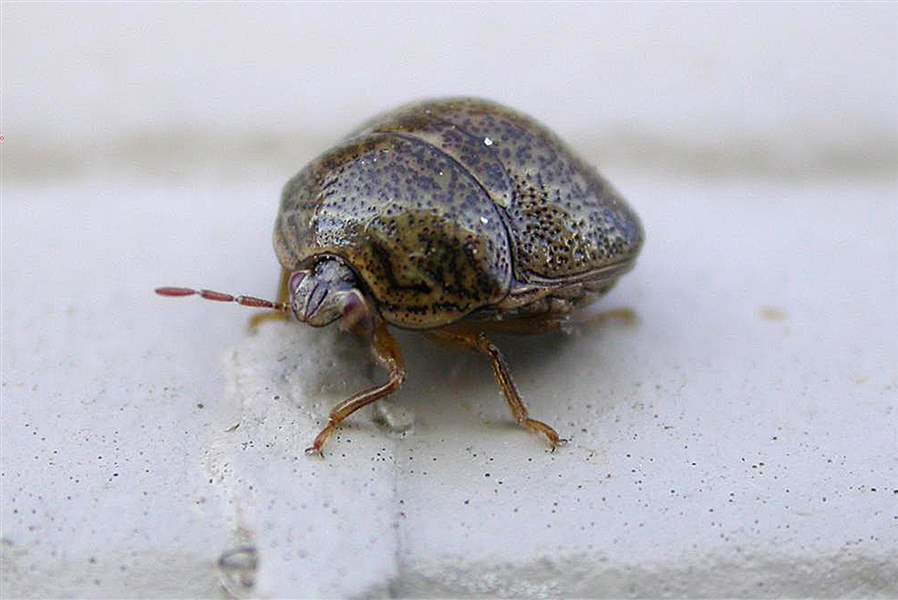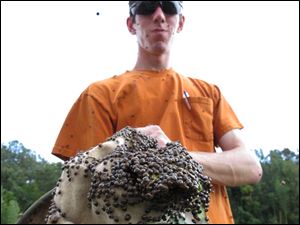
Voracious Asian pests feast on soybean crops
Hardy ‘kudzu bugs’ put a dent in farm income
10/18/2011
The bug breeds and feeds on kudzu patches until soybean planting time, then crosses over to continue the feast.
university of georgia

Clemson University doctoral student Nick Seiter shows a net filled with ‘kudzu bugs’ caught in a test plot in Blackville, S.C. He is studying the invasive creature that wreaks havoc on soybean crops.
BLACKVILLE, S.C. — Kudzu — the “plant that ate the South” — has finally met a pest that’s just as voracious. Trouble is, the so-called “kudzu bug” is also fond of another East Asian transplant that we like and is big money for American farmers.
Soybeans.
“When this insect is feeding on kudzu, it’s beneficial,” Clemson University entomologist Jeremy Greene said as he stood in a field swarming with the brown, pea-sized critters. “When it’s feeding on soybeans, it’s a pest.”
Like kudzu, which was introduced to the South from Japan in the late 19th century as a fodder and a way to stem erosion on the region’s worn-out farmlands, this insect is native to the Far East. And like the invasive vine, which Deliverance author James Dickey famously deemed “a vegetable form of cancer,” the kudzu bug is running rampant.
Megacopta cribrari, as this member of the stinkbug family is known in scientific circles, was identified near Atlanta in late October, 2009. Since then, it has spread to most of Georgia and North Carolina, all of South Carolina, and several counties in Alabama. And it shows no signs of stopping.
Kudzu and soybeans are both legumes. The bug — also known as the bean plataspid — breeds and feeds in the kudzu patches until soybean planting time, then crosses over to continue the moveable feast, said Tracie Jenkins, a plant geneticist at the University of Georgia.
The bugs secrete a caustic substance that smells like a cross between a commercial cleanser and an industrial lubricant. Mr. Greene said it’s unclear whether this is a defensive device, a way of locating each other in a field, or serves some other purpose.
Whatever it’s for, the secretions are potent enough to etch the bottoms of the plastic tubs he uses to ship samples to colleagues.

The bug breeds and feeds on kudzu patches until soybean planting time, then crosses over to continue the feast.
“It’s reducing the ability of the plant to produce or to send photosynthate ... the food that the plant makes from the sun, to the fruit, to the seed,” said Mr. Greene. “So we’re going to have ... a reduced number of pods per plant, reduced number of seed per pod, and reduced seed size as well — all the above,” he said. “It’s not showy in terms of the damage that it does to the plant ... but it’s going to cause yield loss.”
University of Georgia researchers have recorded losses as high as 23 percent in untreated fields.
“If you add up all our insect damage put together of different pests on soybeans, it probably would total maybe in an average year maybe a 5 percent yield loss,” said North Carolina State University pest specialist Jack Bacheler. “And sometimes, with agricultural crops like soybeans, 20 bushels an acre at $10 to $13 could be the difference between profit and loss.”
One thing that concerns Mr. Bacheler and others is the bug’s hardiness. Ms. Jenkins said they may be able to respond to temperature and other environmental changes by turning a gene or genes on or off, making them particularly adaptable. They’ve been found on the windows of Atlanta skyscrapers, from the mountains to the coast.
“And these are pretty resilient little suckers,” she said. “They can get on your car, and you can be going 60, 70, 80 miles an hour down the road, and then you stop, and they’re still there. And they’re alive. So they can take a pretty good lot of abuse.”
In 2010, Georgia produced 6.8 million bushels of soybeans, South Carolina 10.5 million, and North Carolina more than 40 million, according to the American Soybean Association. Ms. Jenkins says there have been unconfirmed sightings in Tennessee, which produced 44 million bushels of soybeans last year.
From there, it’s just a hop, skip and a jump to states such as Illinois and Iowa, where production is in the hundreds of millions of bushels.